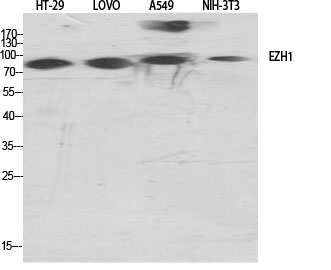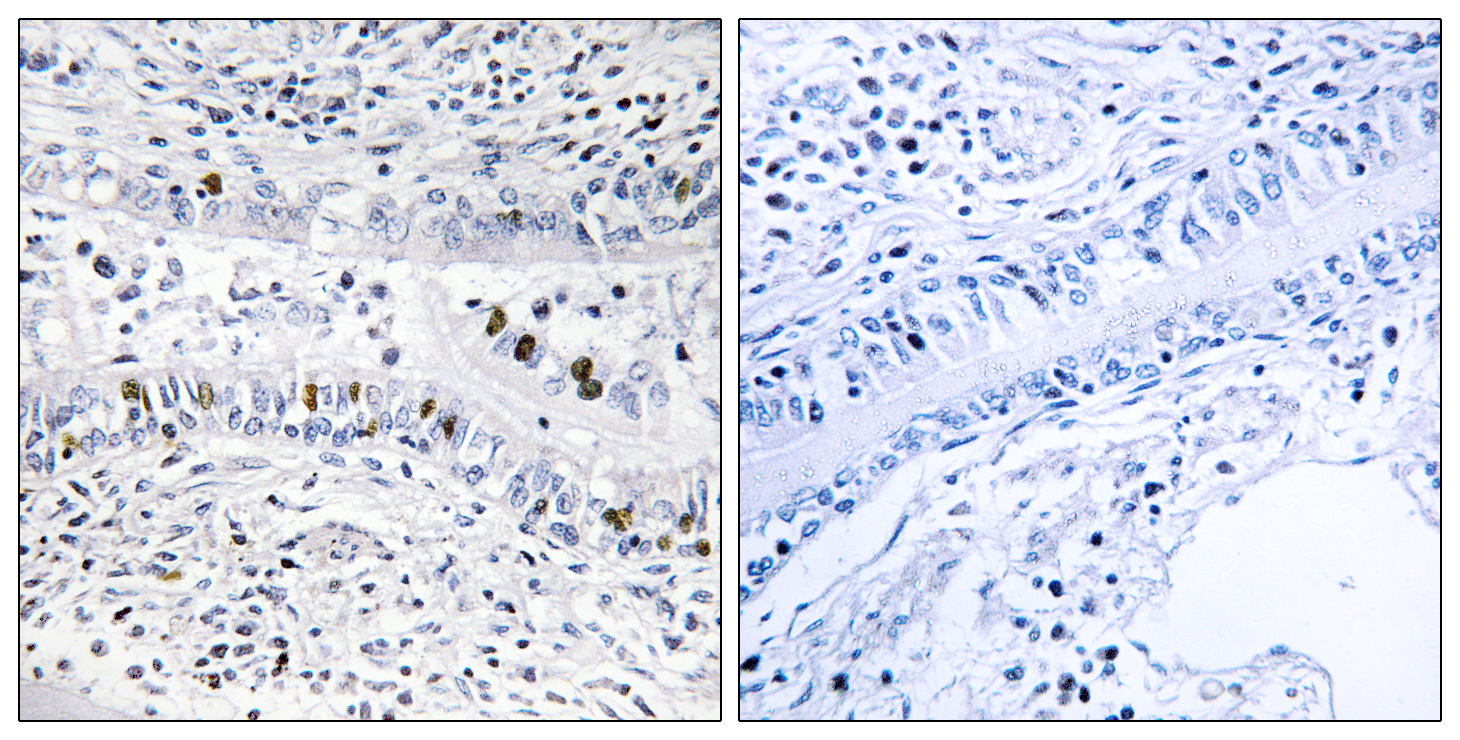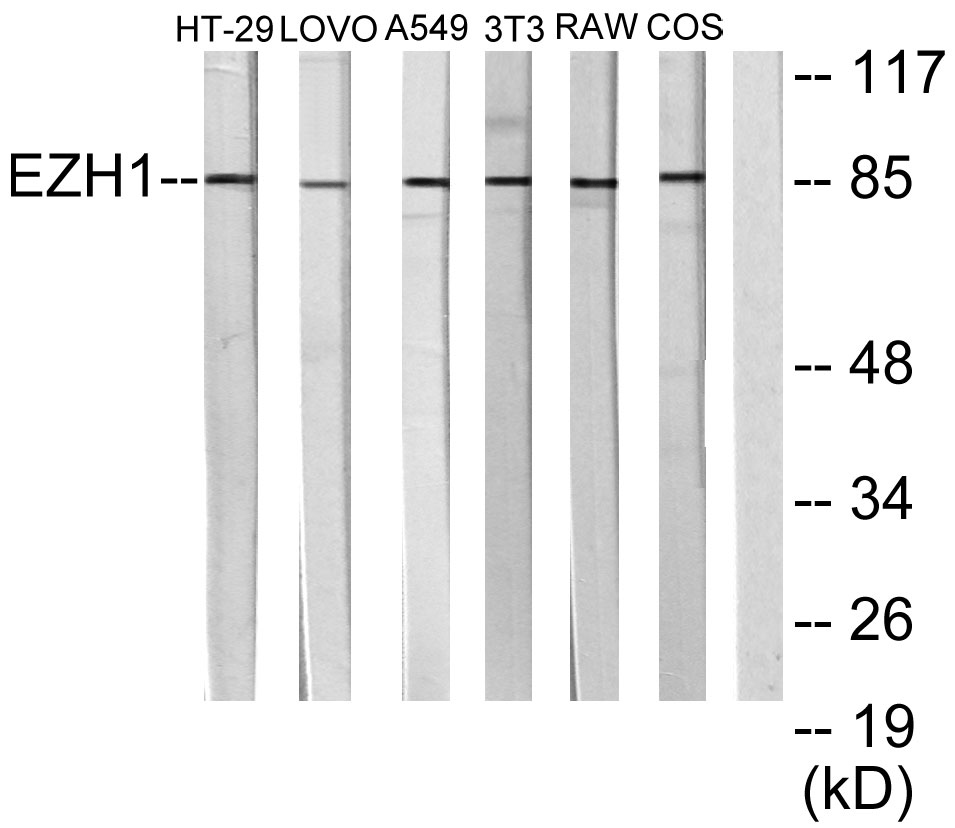ENX-2 Polyclonal Antibody
- Catalog No.:YT1563
- Applications:WB;IHC;IF;ELISA
- Reactivity:Human;Mouse;Monkey
- Target:
- ENX-2
- Fields:
- >>Lysine degradation;>>Metabolic pathways
- Gene Name:
- EZH1
- Protein Name:
- Histone-lysine N-methyltransferase EZH1
- Human Gene Id:
- 2145
- Human Swiss Prot No:
- Q92800
- Mouse Gene Id:
- 14055
- Mouse Swiss Prot No:
- P70351
- Immunogen:
- The antiserum was produced against synthesized peptide derived from human EZH1. AA range:171-220
- Specificity:
- ENX-2 Polyclonal Antibody detects endogenous levels of ENX-2 protein.
- Formulation:
- Liquid in PBS containing 50% glycerol, 0.5% BSA and 0.02% sodium azide.
- Source:
- Polyclonal, Rabbit,IgG
- Dilution:
- WB 1:500 - 1:2000. IHC 1:100 - 1:300. IF 1:200 - 1:1000. ELISA: 1:40000. Not yet tested in other applications.
- Purification:
- The antibody was affinity-purified from rabbit antiserum by affinity-chromatography using epitope-specific immunogen.
- Concentration:
- 1 mg/ml
- Storage Stability:
- -15°C to -25°C/1 year(Do not lower than -25°C)
- Other Name:
- EZH1;KIAA0388;Histone-lysine N-methyltransferase EZH1;ENX-2;Enhancer of zeste homolog 1
- Observed Band(KD):
- 85kD
- Background:
- enhancer of zeste 1 polycomb repressive complex 2 subunit(EZH1) Homo sapiens EZH1 is a component of a noncanonical Polycomb repressive complex-2 (PRC2) that mediates methylation of histone H3 (see MIM 602812) lys27 (H3K27) and functions in the maintenance of embryonic stem cell pluripotency and plasticity (Shen et al., 2008 [PubMed 19026780]).[supplied by OMIM, Mar 2009],
- Function:
- catalytic activity:S-adenosyl-L-methionine + histone L-lysine = S-adenosyl-L-homocysteine + histone N(6)-methyl-L-lysine.,function:Polycomb group (PcG) protein. Catalytic subunit of the PRC2/EED-EZH1 complex, which methylates 'Lys-27' of histone H3, leading to transcriptional repression of the affected target gene. Able to mono-, di- and trimethylate 'Lys-27' of histone H3 to form H3K27me1, H3K27me2 and H3K27me3, respectively. Required for embryonic stem cell derivation and self-renewal, suggesting that it is involved in safeguarding embryonic stem cell identity. Compared to EZH1-containing complexes, it is less abundant in embryonic stem cells and plays a less critical role in forming H3K27me3, which is required for embryonic stem cell identity and proper differentiation.,similarity:Belongs to the histone-lysine methyltransferase family. EZ subfamily.,similarity:Contains 1 SET domain.,s
- Subcellular Location:
- Nucleus . Colocalizes with trimethylated 'Lys-27' of histone H3.
- Expression:
- Brain,Hippocampus,Uterus,
- June 19-2018
- WESTERN IMMUNOBLOTTING PROTOCOL
- June 19-2018
- IMMUNOHISTOCHEMISTRY-PARAFFIN PROTOCOL
- June 19-2018
- IMMUNOFLUORESCENCE PROTOCOL
- September 08-2020
- FLOW-CYTOMEYRT-PROTOCOL
- May 20-2022
- Cell-Based ELISA│解您多样本WB检测之困扰
- July 13-2018
- CELL-BASED-ELISA-PROTOCOL-FOR-ACETYL-PROTEIN
- July 13-2018
- CELL-BASED-ELISA-PROTOCOL-FOR-PHOSPHO-PROTEIN
- July 13-2018
- Antibody-FAQs
- Products Images

- Western Blot analysis of various cells using ENX-2 Polyclonal Antibody cells nucleus extracted by Minute TM Cytoplasmic and Nuclear Fractionation kit (SC-003,Inventbiotech,MN,USA).
.jpg)
- Western Blot analysis of COS7 cells using ENX-2 Polyclonal Antibody cells nucleus extracted by Minute TM Cytoplasmic and Nuclear Fractionation kit (SC-003,Inventbiotech,MN,USA).

- Immunohistochemistry analysis of paraffin-embedded human lung carcinoma tissue, using EZH1 Antibody. The picture on the right is blocked with the synthesized peptide.

- Western blot analysis of lysates from HT-29, LOVO, A549, NIH/3T3, RAW264.7, and COS7 cells, using EZH1 Antibody. The lane on the right is blocked with the synthesized peptide.



